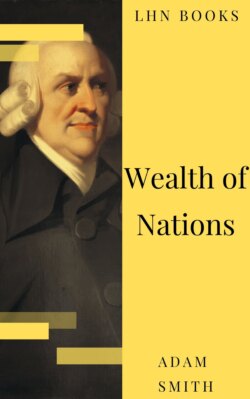Читать книгу Wealth of Nations - Adam Smith, George H. Smith - Страница 17
На сайте Литреса книга снята с продажи.
2. Second Period
ОглавлениеBut how various soever may have been the opinions of the learned concerning the progress of the value of silver during this first period, they are unanimous concerning it during the second.
From about 1570 to about 1640, during a period of about seventy years, the variation in the proportion between the value of silver and that of corn held a quite opposite course. Silver sunk in its real value, or would exchange for a smaller quantity of labour than before; and corn rose in its nominal price, and instead of being commonly sold for about two ounces of silver the quarter, or about ten shillings of our present money, came to be sold for six and eight ounces of silver the quarter, or about thirty and forty shillings of our present money.
The discovery of the abundant mines of America seems to have been the sole cause of this diminution in the value of silver in proportion to that of corn. It is accounted for accordingly in the same manner by everybody; and there never has been any dispute either about the fact or about the cause of it. The greater part of Europe was, during this period, advancing in industry and improvement, and the demand for silver must consequently have been increasing. But the increase of the supply had, it seems, so far exceeded that of the demand, that the value of that metal sunk considerably. The discovery of the mines of America, it is to be observed, does not seem to have had any very sensible effect upon the prices of things in England till after 1570; though even the mines of Potosi had been discovered more than twenty years before.
From 1595 to 1620, both inclusive, the average price of the quarter of nine bushels of the best wheat at Windsor market appears, from the accounts of Eton College, to have been L2 1s. 6 3/4d. From which sum, neglecting the fraction, and deducting a ninth, or 4s. 7 1., the price of the quarter of eight bushels comes out to have been L1 16s. 10 2/3d. And from this sum, neglecting likewise the fraction, and deducting a ninth, or 4s. 1d., for the difference between the price of the best wheat and that of the middle wheat, the price of the middle wheat comes out to have been about L1 12s. 9d., or about six ounces and one-third of an ounce of silver.
From 1621 to 1636, both inclusive, the average price of the same measure of the best wheat at the same market appears, from the same accounts, to have been L2 10s.; from which making the like deductions as in the foregoing case, the average price of the quarter of eight bushels of middle wheat comes out to have been L1 19s. 6d., or about seven ounces and two-thirds of an ounce of silver.
